Game Animals
Non-game Animals
Habitat
Field Borders
- Include trees, grasses, and shrubs, growing around agricultural fields
- Provide food and habitat to many animals including bobwhite quail
- Help protect fields from erosion and runoff of herbicides
Habitat Description: Field Borders
Increasingly larger farms and improvements in farm equipment have provided economic benefits to U.S. farmers. These agricultural changes, however, have also led to the loss of important edge and fence row habitats that were once common around many fields.
Landowners can establish and manage strips of herbaceous or shrubby vegetation on the edge of cropland fields to promote wildlife and improve environmental quality. These areas are commonly known as field borders. Field borders increase plant diversity and provide wildlife habitats. They also provide erosion control and protect water quality by trapping sediment and pollutants.
Properly managed field borders increase plant diversity and the availability of food sources such as seeds and insect prey for bobwhite quail, cottontail rabbits, wild turkeys, gray fox and many other birds and mammals. The benefits of field borders vary depending on the vegetative composition, the width of the borders and the surrounding landscape. Field borders that are part of a network of habitats that include forested areas, grasslands and a variety of crops are likely to attract a wider range of wildlife.
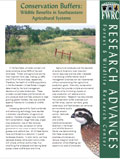
Conservation Buffers: Wildlife Benefits in Southeastern Agricultural Systems (PDF)
Mississippi State University Forest and Wildlife Research Center
Conservation buffers include filter strips, riparian buffers, grass waterways, and field borders. These practices used in conjunction with land management for timber and agriculture can enhance wildlife habitat, provide erosion control, and reduce herbicide runoff. This publication discusses the different types of conservation buffers, the environmental benefits, and the economic benefit to farmers.
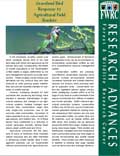
Grassland Bird Response to Agricultural Field Borders (PDF)
Mississippi State University Forest and Wildlife Research Center
Research performed at Mississippi State University the use of agricultural field border management practices and the impact on grassland bird species. "Within intensive agricultural landscapes, field borders provide important idle herbaceous cover for grassland and early successional birds. Field borders may provide nesting, foraging, roosting, loafing, and escape cover. During winter, field borders may provide important habitat in southern agricultural systems where most short distance migrants overwinter. Field borders provide important habitat for many grassland birds due to their greater abundance of food (weed seeds) and more complex vegetation structure compared to non-bordered field margins.
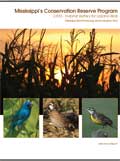
Mississippi's Conservation Reserve Program CP33 (PDF)
Mississippi State University, Natural Resources Conservation Service, Mississippi Department of Wildlife, Fisheries and Parks, USDA Farm Service Agency, Forest and Wildlife Research Center
CP33 field borders or habitat buffers are designed to benefit quail and other grassland bird populations. A research program was initiated in 2006 to study the effects of CP33 native grass habitat buffers on bird populations in Mississippi. The results of this study are presented in this report.
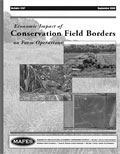
Economic Impact of Conservation Field Borders on Farm Operations (PDF)
Mississippi Agricultural & Forestry Experiment Station Bulletin
A study to determine the financial effects of conservation buffers in the growth of corn and soybeans took place in central Mississippi from 1999 to 2003. This publication discusses how that study was conducted and its results.
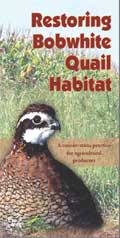
Restoring Bobwhite Quail Habitat (PDF)
MDWFP, MS Fish and Wildlife Foundation, Delta Wildlife Inc., MSU Forest and Wildlife Research Center
This brochure talks about the conservation practice CP33: Habitat buffers for upland birds. Mississippi State University, along with number of cooperators, recently developed a DVD to promote the CP33 practice. The DVD was developed for agricultural producers, and explains both the economics and wildlife benefits of the CP33 practice. Anyone interested in obtaining a copy of the DVD or brochure should contact Wes Burger at Mississippi State University, Department of Wildlife and Fisheries, Mississippi State, MS 39762-9690; email wburger@cfr.msstate.edu. Single copies are free, and larger orders can be purchased for a nominal cost.

Farm-level Habitat Management for Bobwhite Quail and Other Farm Wildlife (PDF)
Mississippi State University Forest and Wildlife Research Center
Practices that agricultural producers can use to increase or improve wildlife habitat on their lands are discussed in this brochure. A brief discussion of managing vegetative buffers, grassland habitat, and woodlands for wildlife habitat is given as well as a mention of the cost-share programs available.
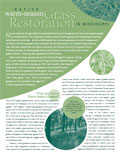
Native Warm-Season Grass Restoration in Mississippi (PDF)
Mississippi State University Forest and Wildlife Research Center
This publication defines native warm season grasses, lists examples of the types of warm season grasses and provides labeled drawings of the types. It describes the benefits of restoring native grasses and how to do so. Information is provided on keeping different non-native grass species under control. Information is also given on choosing and planting grass species in a way that restores ecosystems and is advantageous to wildlife or creates livestock forage. Use of periodic disturbances is also covered along with contact information for organizations that assist with management of warm season grasses.
Conservation Buffers (PDF)
Wildlife Trends, Volume 5, Issue 2
Private landowners can improve wildlife habitat and provide other environmental benefits through practices such as conservation buffers that are easily integrated with production agriculture. Field borders may also benefit the farmer economically by taking low-yielding field margins and enrolling them in cost-share programs. This article discusses the many types of conservation buffers and the benefits that each type can provide. In addition, it provides information on the conservation programs that can provide assistance with the installation of field borders.
What Makes Some Field Border Habitats Better Than Others? (PDF)
N.C. State University
Does the shape of a field border affect bobwhite quail nesting and brood-rearing? Does the landscape that surrounds a farm with field borders impact bobwhite quail? This research showed that where suitable bobwhite quail habitat was aggregated together in farm areas, bobwhite quail numbers increased regardless of field border shape. On farms where surrounding habitat is forested, nonlinear field borders showed a larger increase in quail numbers than linear field borders.
Grassland Bird Population Responses to Upland Habitat Buffer Establishment (PDF)
USDA NRCS Wildlife Insight No. 86
Conservation buffers provide habitat for grassland birds in agricultural fields while also retaining nutrients and herbicides, reducing soil erosion, and enhancing water quality. The USDA Farm Service Agency created CP33 Habitat Buffers for Upland Birds, a new CRP conservation buffer practice, in 2004. This research investigated the effects of upland habitat buffers on grassland birds on three privately owned farms in Mississippi.
Bobwhite and Upland Songbird Response to CCRP Practice CP33, Habitat Buffers for Upland Birds (PDF)
Natural Resources Conservation Service
The Continuous Conservation Reserve Program (CCRP) CP33 creates wildlife habitat along field borders of cropland. It was established in 2004. This publication discusses the results from the monitoring program and responses of grassland birds and bobwhite quail to this program.
Conservation Buffers and Water Quality (PDF)
Iowa State University Extension
Conservation buffers are any type of permanent vegetation in or around row crops. These include filter strips, riparian buffers, field borders, shallow water areas, grassed waterways, field windbreaks, shelterbelts, wellhead protection areas, living snow fences, and contour grass strips. These buffers help protect water quality and fish, increase wildlife habitat, reduce soil erosion, and more. This publication discusses where to put conservation buffers, how to make a conservation buffer, and how to manage them.

